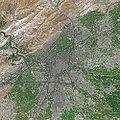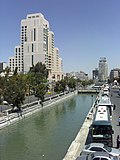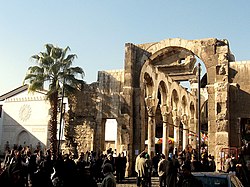Damascus
Damascus is the capital city of Syria. In Arabic, its name is Dimashq (دمشق). It is the largest city in Syria with about 4.8 million people living there. Damascus is thought to be one of oldest cities in the world that still has people living in it. It is believed that people started living in Damascus as long ago as 8000 BC to 10,000 BC (12000 years ago).
|
دمشق | |
|---|---|
 | |
|
| |
| Coordinates: 33°30′47″N 36°17′31″E / 33.51306°N 36.29194°ECoordinates: 33°30′47″N 36°17′31″E / 33.51306°N 36.29194°E | |
| Country | |
| Governorates | Damascus Governorate, Capital City |
| Government | |
| • Governor | Bishr Al Sabban |
| Area | |
| • City | 105 km2 (41 sq mi) |
| • Urban | 77 km2 (30 sq mi) |
| Elevation | 680 m (2,230 ft) |
| Population (2009 est.[1]) | |
| • City | 1,711,000 |
| Time zone | UTC+2 (EET) |
| • Summer (DST) | UTC+3 (EEST) |
| Demonym | Damascene |
| Website | Damascus Governorate |
| Sources: Damascus city area[2] | |
Location
Damascus is about 50 miles inland from the Mediterranean Sea, sheltered by the Anti-Lebanon Mountains.
Economy
Damascus used to play an important role as an important trade center. Now it is not because of political development in the region as well as the development of modern trade.[3] Most goods produced in Damascus, as well as in Syria, are distributed to countries of the Arabian peninsula.[3] Damascus also holds an annual international trade exposition in the fall since 1955.
Education
There are many universities in Damascus, one public university: Damascus University.[4] while other universities are private, such as the Syrian Private University [5] and the aljazeera Private University.[6]
Historical sites
Damascus has many historical sites dating back to many different periods of the city's history. Since the city has been built up with every passing job, it has become almost impossible to dig out all the ruins of Damascus that lie up to 8 feet (2.4 m) below the modern level. The Citadel of Damascus is in the northwest corner of the Old City. The Bab Sharqi street is filled with small shops and leads to the old Christian quarter of Bab Tuma (St. Thomas's Gate). Medhat Pasha Souq is also a main market in Damascus and was named after Medhat Pasha. At the end of the Bab Sharqi street, one reaches the House of Ananias, an underground chapel that was the cellar of Ananias's house. The Umayyad Mosque, also known as the Grand Mosque of Damascus, is one of the largest mosques in the world and also one of the oldest sites of continuous prayer since the rise of Islam.
Image gallery
Damascus Media
Damascus in spring seen from Spot satellite
Mount Qasioun overlooking the city
One of the rare periods the Barada river is high, seen here next to the Four Seasons hotel in downtown Damascus
Ruins of the Jupiter Temple at the entrance of Al-Hamidiyah Souq
The Biblical Street called Straight of Damascus
Courtyard of the Umayyad Mosque
References
- ↑ Central Bureau Of Statistics in Syria: Chapter 2: Population & Demographic Indicators Archived 2011-02-13 at the Wayback Machine Table 3: Estimates of Population actually living in Syria in 31 December 2011 by Mohafazat and six (in thousands)
- ↑ Albaath.news statement by the governor of Damascus, Syria Archived 2011-05-16 at the Wayback Machine (in Arabic), April 2010
- ↑ 3.0 3.1 "Damascus". Encyclopædia Britannica. Retrieved 2009-11-28.
- ↑ Workers, Damascus. "جامعة دمشق". www.damascusuniversity.edu.sy. Retrieved 2018-12-02.
- ↑ (in en-EN) Syrian Private University. http://spu.edu.sy/index.php?&lang=2. Retrieved 2018-12-02.
- ↑ (in en-EN) Aljazeera Private University. http://jude.edu.sy/. Retrieved 2018-12-02.
Other websites
| Wikimedia Commons has media related to Lua error in Module:Commons_link at line 62: attempt to index field 'wikibase' (a nil value).. |
- eDamascus - Official website for Damascus
- Damascus Online - Brief information about the city of Damascus
- The 31 Places to Go in 2010 (The New York Times)















